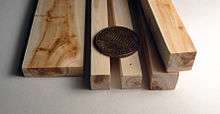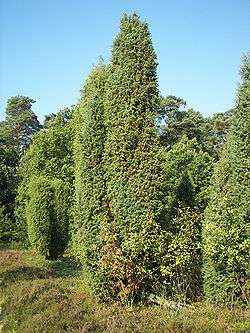Juniperus communis
| Juniperus communis | |
|---|---|
 | |
| Juniperus communis subsp. communis in the Netherlands | |
| Scientific classification | |
| Kingdom: | Plantae |
| Division: | Pinophyta |
| Class: | Pinopsida |
| Order: | Pinales |
| Family: | Cupressaceae |
| Genus: | Juniperus |
| Species: | J. communis |
| Binomial name | |
| Juniperus communis L. | |
 | |
| Natural range world-wide | |
 | |
| Natural range in North America | |
Juniperus communis, the common juniper, is a species of conifer in the genus Juniperus, in the family Cupressaceae. It has the largest geographical range of any woody plant, with a circumpolar distribution throughout the cool temperate Northern Hemisphere from the Arctic south in mountains to around 30°N latitude in North America, Europe and Asia. Relict populations can be found in the Atlas Mountains of Africa.
Description
Juniperus communis is a small coniferous evergreen tree or shrub, very variable in form, ranging from 10 m (33 ft)—rarely 16 m (52 ft)—tall to a low, often prostrate spreading shrub in exposed locations. It has needle-like leaves in whorls of three; the leaves are green, with a single white stomatal band on the inner surface. It never attains adult foliage.[2]:55 It is dioecious, with male and female cones, which are wind pollinated, on separate plants.
The fruit are berry-like cones, initially green, ripening in 18 months to purple-black with a blue waxy coating; they are spherical, 4–12 mm (0.16–0.47 in) diameter, and usually have three (occasionally six) fleshy fused scales, each scale with a single seed. The seeds are dispersed when birds eat the cones, digesting the fleshy scales and passing the hard, unwinged seeds in their droppings. The male cones are yellow, 2–3 mm (0.079–0.118 in) long, and fall soon after shedding their pollen in March–April.[3][4][5]
Subspecies
As to be expected from the wide range, J. communis is very variable, with several infraspecific taxa; delimitation between the taxa is still uncertain, with genetic data not matching morphological data well.[3][4][5][6][7][8][9][10]
- subsp. communis – Common juniper. Usually an erect shrub or small tree; leaves long, 8–20(–27) mm; cones small, 5–8 mm, usually shorter than the leaves; found at low to moderate altitude in temperate climates.
- subsp. communis var. communis – Europe, most of northern Asia
- subsp. communis var. depressa Pursh – North America, Sierra Nevada in California
- subsp. communis var. hemisphaerica (J.Presl & C.Presl) Parl. – Mediterranean mountains
- subsp. communis var. nipponica (Maxim.) E.H.Wilson – Japan (status uncertain, often treated as J. rigida var. nipponica)
- subsp. alpina (Suter) Čelak. – alpine juniper (syn. J. c. subsp. nana, J. c. var. saxatilis Pallas, J. sibirica Burgsd.). Usually a prostrate ground-hugging shrub; leaves short, 3–8 mm; cones often larger, 7–12 mm, usually longer than the leaves; found in subarctic areas and high altitude alpine zones in temperate areas.
- subsp. alpina var. alpina – Greenland, Europe and Asia
- subsp. alpina var. megistocarpa Fernald & H.St.John – Eastern Canada (doubtfully distinct from var. alpina)
- subsp. alpina var. jackii Rehder – Western North America (doubtfully distinct from var. alpina)
Some botanists treat subsp. alpina at the lower rank of variety, in which case the correct name is Juniperus communis var. saxatilis Pallas,[4] though the name Juniperus communis var. montana is also occasionally cited; others, primarily in eastern Europe and Russia, sometimes treat it as a distinct species J. sibirica Burgsd. (syn. J. nana Willd., J. alpina S.F.Gray).[11]
Juniperus communis is one of Ireland's longest established plants.[12]
Uses

Cultivation
Juniperus communis is cultivated in the horticulture trade and used as an evergreen ornamental shrub in gardens. The following cultivars gained the Royal Horticultural Society's Award of Garden Merit in 1993:[13]
- Juniperus communis 'Compressa'[14]
- Juniperus communis 'Green Carpet'[15]
- Juniperus communis 'Hibernica' (Irish juniper)[16]
- Juniperus communis 'Repanda'[17]
Crafts

It is too small to have any general lumber usage. In Scandinavia, however, juniper wood is used for making containers for storing small quantities of dairy products such as butter and cheese, and also for making wooden butter knives. It was also frequently used for trenails in wooden shipbuilding by shipwrights for its tough properties.
In Estonia juniper wood is valued for its long lasting and pleasant aroma, very decorative natural structure of wood (growth rings) as well as good physical properties of wood due to slow growth rate of juniper and resulting dense and strong wood. Various decorative items (often eating utensils) are common in most Estonian handicraft shops and households.
According to the old tradition, on Easter Monday Kashubian (Northern Poland) boys chase girls whipping their legs gently with juniper twigs. This is to bring good fortune in love to the chased girls.
Culinary
Its astringent blue-black seed cones, commonly known as "juniper berries", are too bitter to eat raw and are usually sold dried and used to flavour meats, sauces, and stuffings. They are generally crushed before use to release their flavour. Since juniper berries have a strong taste, they should be used sparingly. They are generally used to enhance meat with a strong flavour, such as game, including game birds, or tongue.
The cones are used to flavour certain beers and gin (the word "gin" derives from an Old French word meaning "juniper").[18] In Finland, juniper is used as a key ingredient in making sahti, a traditional Finnish ale. Also the Slovak alcoholic beverage Borovička and Dutch Genever are flavoured with juniper berry or its extract.
Juniper is used in the traditional farmhouse ales of Norway,[19] Sweden,[20] Finland,[21] Estonia, and Latvia. In Norway, the beer is brewed with juniper infusion instead of water, while in the other countries the juniper twigs are mainly used in the mash, as filters to prevent the crushed malts from clogging the outlet of the mashing tun.
Traditional medicine
Juniper berries have long been used as medicine by many cultures including the Navajo people.[22] Western American tribes combined the berries of Juniperus communis with Berberis root bark in a herbal tea. Native Americans also used juniper berries as a female contraceptive.[23]
Gallery

 Juniperus communis subsp. communis on Lüneburg Heath, Germany
Juniperus communis subsp. communis on Lüneburg Heath, Germany- Young shoots, Malá Fatra
References
| Wikimedia Commons has media related to Juniperus communis. |
- ↑ Conifer Specialist Group 1998. Juniperus communis. In: IUCN 2009. IUCN Red List of Threatened Species. Version 2009.2. <www.iucnredlist.org>. Downloaded on 3 March 2010.
- ↑ Stace, C.A. (2010). New flora of the British Isles (Third ed.). Cambridge, U.K.: Cambridge University Press. ISBN 9780521707725.
- 1 2 Rushforth, K. (1987). Conifers. Helm ISBN 0-7470-2801-X.
- 1 2 3 Adams, R. P. (2004). Junipers of the World: The genus Juniperus. Victoria: Trafford. ISBN 1-4120-4250-X.
- 1 2 Arboretum de Villardebelle: Juniperus
- ↑ Flora Europaea: Juniperus communis
- ↑ Adams, R. P., Pandey, R. N., Leverenz, J. W., Dignard, N., Hoegh, K., & Thorfinnsson, T. (2003). Pan-Arctic variation in Juniperus communis: Historical Biogeography based on DNA fingerprinting. Biochem. Syst. Ecol. 31: 181-192 pdf file.
- ↑ Adams, R. P., & Pandey, R. N. (2003). Analysis of Juniperus communis and its varieties based on DNA fingerprinting. Biochem. Syst. Ecol. 31: 1271-1278. pdf file
- ↑ Adams, R. P., & Nguyen, S. (2007). Post-Pleistocene geographic variation in Juniperus communis in North America. Phytologia 89 (1): 43-57. pdf file
- ↑ Den Virtuella Floran: Juniperus communis distribution
- ↑ Association Ecosystem (Russia): Juniperus sibirica
- ↑ Preston, S. J.; Wilson, C.; Jennings, S.; Provan, J.; McDonald, R. A. (2007). "The status of Juniperus communis L. in Northern Ireland in 2005". Ir. Nat. J. 28: 372–378.
- ↑ "AGM ornamentals". London: Royal Horticultural Society. 2015.
- ↑ "Juniperus communis Compressa". London: Royal Horticultural Society. 2015.
- ↑ "Juniperus communis Green Carpet". London: Royal Horticultural Society. 2015.
- ↑ "Juniperus communis Hibernica". London: Royal Horticultural Society. 2015.
- ↑ "Juniperus communis Repanda". London: Royal Horticultural Society. 2015.
- ↑ Shorter Oxford English dictionary (6th ed.). United Kingdom: Oxford University Press. 2007. p. 3804. ISBN 0199206872.
- ↑ Brewing and beer traditions in Norway: The social anthropological background of the brewing industry, Odd Nordland, Universitetsforlaget, 1969.
- ↑ Gotlandsdricka: Traditionell kultur som regional identitetssymbol, Anders Salomonsson, Skrifter utg. av Etnologiska sallskapet i Lund, 1979, ISBN 917400106X .
- ↑ Vom Halm zum Fass: Die volkstumlichen Alkoholarmen : Getreidegetranke in Finnland, Matti Räsänen, Kansatieteellinen arkisto, 1975.
- ↑ McCabe, Melvina; Gohdes, Dorothy; Morgan, Frank; Eakin, Joanne; Sanders, Margaret; Schmitt, Cheryl (2005). "Herbal Therapies and Diabetes Among Navajo Indians". Diabetes Care. 28 (6): 1534–1535. doi:10.2337/diacare.28.6.1534-a.
- ↑ Tilford, Gregory L. (1997). Edible and Medicinal Plants of the West. Mountain Press Publishing Company. ISBN 0-87842-359-1.
Further reading
- Conifer Specialist Group (1998). "Juniperus communis". IUCN Red List of Threatened Species. Version 2006. International Union for Conservation of Nature. Retrieved 12 May 2006. Database entry includes a brief justification of why this species is of least concern
External links
| Wikimedia Commons has media related to Juniperus communis. |
- USDA: Juniperus communis
- Jepson Manual Treatment - Juniperus communis
- Juniperus communis - Photo Gallery
- EUFORGEN species page on Juniperus communis Information, genetic conservation units and related resources

